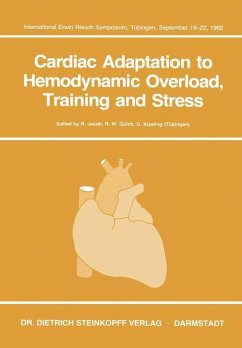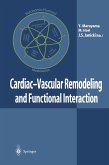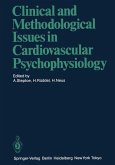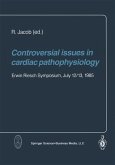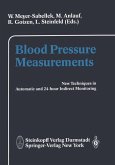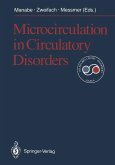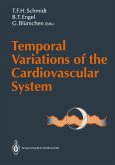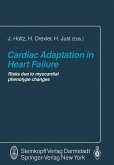Cardiac Adaptation to Hemodynamic Overload, Training and Stress
Herausgegeben von Jacob, R.; Gülch, R.; Kissling, G.
Cardiac Adaptation to Hemodynamic Overload, Training and Stress
Herausgegeben von Jacob, R.; Gülch, R.; Kissling, G.
- Broschiertes Buch
- Merkliste
- Auf die Merkliste
- Bewerten Bewerten
- Teilen
- Produkt teilen
- Produkterinnerung
- Produkterinnerung
Cardiac hypertrophy and accompanying phenomena have received increasing attention in recent years - particularly in the basic sciences. The present volume contains the proceedings of the Erwin RIESCH SYMPOSIUM on "CARDIAC ADAPTATION TO HEMODYNAMIC OVERLOAD, TRAINING AND STRESS" held in Tiibingen on Sep tember 19-22, 1982. In addition to the topics of the previous symposia (1976 and 1979) concerned with problems of cardiac hypertrophy, the scope of this sequel meeting has been expanded to include related fields. The intention was to consider numerous related features and problems of chronic…mehr
Andere Kunden interessierten sich auch für
![Cardiac-Vascular Remodeling and Functional Interaction Cardiac-Vascular Remodeling and Functional Interaction]() Cardiac-Vascular Remodeling and Functional Interaction41,99 €
Cardiac-Vascular Remodeling and Functional Interaction41,99 €![Clinical and Methodological Issues in Cardiovascular Psychophysiology Clinical and Methodological Issues in Cardiovascular Psychophysiology]() Clinical and Methodological Issues in Cardiovascular Psychophysiology41,99 €
Clinical and Methodological Issues in Cardiovascular Psychophysiology41,99 €![Controversial issues in cardiac pathophysiology Controversial issues in cardiac pathophysiology]() Controversial issues in cardiac pathophysiology40,99 €
Controversial issues in cardiac pathophysiology40,99 €![Blood Pressure Measurements Blood Pressure Measurements]() Blood Pressure Measurements118,99 €
Blood Pressure Measurements118,99 €![Microcirculation in Circulatory Disorders Microcirculation in Circulatory Disorders]() Microcirculation in Circulatory Disorders75,99 €
Microcirculation in Circulatory Disorders75,99 €![Temporal Variations of the Cardiovascular System Temporal Variations of the Cardiovascular System]() Temporal Variations of the Cardiovascular System38,99 €
Temporal Variations of the Cardiovascular System38,99 €![Cardiac Adaptation in Heart Failure Cardiac Adaptation in Heart Failure]() Cardiac Adaptation in Heart Failure79,99 €
Cardiac Adaptation in Heart Failure79,99 €-
-
-
Cardiac hypertrophy and accompanying phenomena have received increasing attention in recent years - particularly in the basic sciences. The present volume contains the proceedings of the Erwin RIESCH SYMPOSIUM on "CARDIAC ADAPTATION TO HEMODYNAMIC OVERLOAD, TRAINING AND STRESS" held in Tiibingen on Sep tember 19-22, 1982. In addition to the topics of the previous symposia (1976 and 1979) concerned with problems of cardiac hypertrophy, the scope of this sequel meeting has been expanded to include related fields. The intention was to consider numerous related features and problems of chronic reactions of the heart (and vascular system) to abnormal hemodynamic loading, as well as alterations due to maturation, aging, training, neuroendocrine status and stress. Special attention has been paid to cardiac reactions at the level of contractile proteins. The results are considered primarily in light of long-term adaptation of the heart. Of course, research at the forefront of current knowledge need not always lead to congruent conclusions. Neither can the individual contributions always agree with the viewpoint of the editors. However, the broad array of individual approaches employed by biochemists, biolo gists, pathologists, physiologists, pharmacologists and clinical cardio logists will certainly help to provide a more balanced interpretation of the results in individual fields, stimulate reexamination of established con cepts and provide direction for future research.
Hinweis: Dieser Artikel kann nur an eine deutsche Lieferadresse ausgeliefert werden.
Hinweis: Dieser Artikel kann nur an eine deutsche Lieferadresse ausgeliefert werden.
Produktdetails
- Produktdetails
- Verlag: Steinkopff
- Artikelnr. des Verlages: 86005482, 978-3-642-85328-9
- Softcover reprint of the original 1st ed. 1983
- Seitenzahl: 384
- Erscheinungstermin: 25. Dezember 2011
- Englisch
- Abmessung: 244mm x 170mm x 21mm
- Gewicht: 660g
- ISBN-13: 9783642853289
- ISBN-10: 3642853285
- Artikelnr.: 36146745
- Herstellerkennzeichnung Die Herstellerinformationen sind derzeit nicht verfügbar.
- Verlag: Steinkopff
- Artikelnr. des Verlages: 86005482, 978-3-642-85328-9
- Softcover reprint of the original 1st ed. 1983
- Seitenzahl: 384
- Erscheinungstermin: 25. Dezember 2011
- Englisch
- Abmessung: 244mm x 170mm x 21mm
- Gewicht: 660g
- ISBN-13: 9783642853289
- ISBN-10: 3642853285
- Artikelnr.: 36146745
- Herstellerkennzeichnung Die Herstellerinformationen sind derzeit nicht verfügbar.
Editorial.- Chronic reactions of myocardium at the myofibrillar level. Reflexions on "adaptation" and "disease" based on the biology of long-term cardiac overload.- Fundamental biochemical processes - Control of myocardial cell growth and gene expression.- Molecular dynamics of contraction - relaxation.- Effects of activity on some physiological properties of skeletal muscles.- Relationship between the synthesis rates and mRNA levels af the ? and ? cardiac myosin heavy chains in normal and thyrotoxic rabbits.- Dissociation between factors resulting in hypertrophy and changes in myosin isoenzyme population of the pressure-loaded rat heart.- Dissociation of hypertrophy and altered function in senescent rat myocardium.- Differential effect of thyroid hormones on catecholamine enzymes and myosin isoenzymes in ventricles and atria of the rat heart.- The adrenals in experimental cardiac hypertrophy.- Myocardial nucleus in growing and hypertrophied heart.- A pathomorphological study on the diabetogenic drug induced heart disease in the rat.- The role of cyclic nucleotides in the pathogenesis of myocardial hypertrophy.- The role of cytoplasmic factors in RNA synthesis activation during hyper-function of heart and liver.- New trends in biology of cardiac overload: plasma membranes, enzymes, cytoskeleton proteins and in vitro traduction of RNA.- Structural changes of contractile proteins.- Adaptive changes in cardiac isomyosins as visualized by immunofluorescence.- Myosin isoenzymic distribution in hypertrophied rat and human hearts.- Thyroxine-induced molecular alteration of heavy and 27,000-dalton light chains of rabbit ventricular myosin. Reconstitution of heavy and light chain molecules of subfragment-1 isozymes of cardiac myosin.- Structural variants of heavyand light chains of atrial and ventricular myosins in hypertrophied human hearts.- Myosin isozymes in normal and pathological human cardiac muscle.- Structural and enzymatic alterations of cardiac contractile proteins under chronic pressure overload.- The phosphorylation of cardiac contractile proteins.- Morphological and functional aspects of adaptation or damage.- Isoenzyme contribution to economy of contraction and relaxation in normal and hypertrophied hearts.- Heat liberation in experimentally induced tetanic contractions of myocardium from normal and Goldblatt rats.- Energetics of the rat heart in chronic pressure overload.- Alterations in electrical properties of rat myocardium accompanying different models of cardiac hypertrophy.- Calcium binding and Na-Ca exchange in cardiac sarcolemma in experimental hypertension.- Cardiac muscle function during the development of hypertrophy in pigs due to pressure overload.- Biochemical and mechanical correlates at peak systole in myopathic Syrian Hamster.- Buffer capacity of the myocardium after swimming training.- Coronary circulation, ischemia, adenine nucleotide content in cardiac overload.- Coronary reserve in spontaneously hypertensive rats: the effect of blood pressure, hypertrophy and long-term vasodilator therapy.- Effect of aortic constriction on rat heart function and mortality.- Metabolic effects of low-flow ischemia on the perfused hypertrophied rat heart: a phosphorus (31P) nuclear magnetic resonance (NMR) study.- Myocardial mechanics of infarcted and hypertrophied non-infarcted myocardium following experimental coronary artery occlusion.- The interference of respiratory chain function with lipid metabolism in the left ventricular myocardium of rats with compensated chronical volume overload.- Neuroendocrine,cardiac and vascular alterations in hypertension and stress - Pathogenesis, and effects of interventions.- Cardiovascular abnormalities in spontaneously hypertensive rats. Causes or consequences of the increased blood pressure?.- Mechanisms of heart sarcolplasmic reticulum damage under stress.- Changes of heart catecholamine levels, metabolism and adrenergic receptors in actually and repeatedly stressed rats.- Modulation of catecholamine synthesizing and degrading enzymes by swimming and emotional excitation in the rat.- Blood pressure and cardiac myosin heterogeneity in the rat as influenced by swimming and emotional excitation.- Calcium-Antagonism: A new therapeutic access to hypertensive heart disease.- Magnesium as the physiologic calcium antagonist: its vascular effects and therapeutic use.- Reactions at the tissue level.- Effects of hemodynamic load on myocardial fibre orientation.- Biochemical characteristics and cellular mechanisms of fibrotic processes.- Cardiovascular aging.- Connective tissue alterations in coronary arteries of spontaneously hypertensive rats (SHR); electron microscopic and morphometrical investigation.- Myocardial mass and collagen content in Crotalaria spectabilis-induced pulmonary hypertension of young and adult rats.- Heterogeneity of collagen in the normal and hypertrophied left ventricle of the rat.- Determination of left ventricular diastolic wall stress and elasticity in situ. A methodological investigation.- The influence of antihypertensive treatment on left ventricular compliance and myocardial stiffness.- Acknowledgements.- Authors' Index.
Editorial.- Chronic reactions of myocardium at the myofibrillar level. Reflexions on "adaptation" and "disease" based on the biology of long-term cardiac overload.- Fundamental biochemical processes - Control of myocardial cell growth and gene expression.- Molecular dynamics of contraction - relaxation.- Effects of activity on some physiological properties of skeletal muscles.- Relationship between the synthesis rates and mRNA levels af the ? and ? cardiac myosin heavy chains in normal and thyrotoxic rabbits.- Dissociation between factors resulting in hypertrophy and changes in myosin isoenzyme population of the pressure-loaded rat heart.- Dissociation of hypertrophy and altered function in senescent rat myocardium.- Differential effect of thyroid hormones on catecholamine enzymes and myosin isoenzymes in ventricles and atria of the rat heart.- The adrenals in experimental cardiac hypertrophy.- Myocardial nucleus in growing and hypertrophied heart.- A pathomorphological study on the diabetogenic drug induced heart disease in the rat.- The role of cyclic nucleotides in the pathogenesis of myocardial hypertrophy.- The role of cytoplasmic factors in RNA synthesis activation during hyper-function of heart and liver.- New trends in biology of cardiac overload: plasma membranes, enzymes, cytoskeleton proteins and in vitro traduction of RNA.- Structural changes of contractile proteins.- Adaptive changes in cardiac isomyosins as visualized by immunofluorescence.- Myosin isoenzymic distribution in hypertrophied rat and human hearts.- Thyroxine-induced molecular alteration of heavy and 27,000-dalton light chains of rabbit ventricular myosin. Reconstitution of heavy and light chain molecules of subfragment-1 isozymes of cardiac myosin.- Structural variants of heavyand light chains of atrial and ventricular myosins in hypertrophied human hearts.- Myosin isozymes in normal and pathological human cardiac muscle.- Structural and enzymatic alterations of cardiac contractile proteins under chronic pressure overload.- The phosphorylation of cardiac contractile proteins.- Morphological and functional aspects of adaptation or damage.- Isoenzyme contribution to economy of contraction and relaxation in normal and hypertrophied hearts.- Heat liberation in experimentally induced tetanic contractions of myocardium from normal and Goldblatt rats.- Energetics of the rat heart in chronic pressure overload.- Alterations in electrical properties of rat myocardium accompanying different models of cardiac hypertrophy.- Calcium binding and Na-Ca exchange in cardiac sarcolemma in experimental hypertension.- Cardiac muscle function during the development of hypertrophy in pigs due to pressure overload.- Biochemical and mechanical correlates at peak systole in myopathic Syrian Hamster.- Buffer capacity of the myocardium after swimming training.- Coronary circulation, ischemia, adenine nucleotide content in cardiac overload.- Coronary reserve in spontaneously hypertensive rats: the effect of blood pressure, hypertrophy and long-term vasodilator therapy.- Effect of aortic constriction on rat heart function and mortality.- Metabolic effects of low-flow ischemia on the perfused hypertrophied rat heart: a phosphorus (31P) nuclear magnetic resonance (NMR) study.- Myocardial mechanics of infarcted and hypertrophied non-infarcted myocardium following experimental coronary artery occlusion.- The interference of respiratory chain function with lipid metabolism in the left ventricular myocardium of rats with compensated chronical volume overload.- Neuroendocrine,cardiac and vascular alterations in hypertension and stress - Pathogenesis, and effects of interventions.- Cardiovascular abnormalities in spontaneously hypertensive rats. Causes or consequences of the increased blood pressure?.- Mechanisms of heart sarcolplasmic reticulum damage under stress.- Changes of heart catecholamine levels, metabolism and adrenergic receptors in actually and repeatedly stressed rats.- Modulation of catecholamine synthesizing and degrading enzymes by swimming and emotional excitation in the rat.- Blood pressure and cardiac myosin heterogeneity in the rat as influenced by swimming and emotional excitation.- Calcium-Antagonism: A new therapeutic access to hypertensive heart disease.- Magnesium as the physiologic calcium antagonist: its vascular effects and therapeutic use.- Reactions at the tissue level.- Effects of hemodynamic load on myocardial fibre orientation.- Biochemical characteristics and cellular mechanisms of fibrotic processes.- Cardiovascular aging.- Connective tissue alterations in coronary arteries of spontaneously hypertensive rats (SHR); electron microscopic and morphometrical investigation.- Myocardial mass and collagen content in Crotalaria spectabilis-induced pulmonary hypertension of young and adult rats.- Heterogeneity of collagen in the normal and hypertrophied left ventricle of the rat.- Determination of left ventricular diastolic wall stress and elasticity in situ. A methodological investigation.- The influence of antihypertensive treatment on left ventricular compliance and myocardial stiffness.- Acknowledgements.- Authors' Index.

